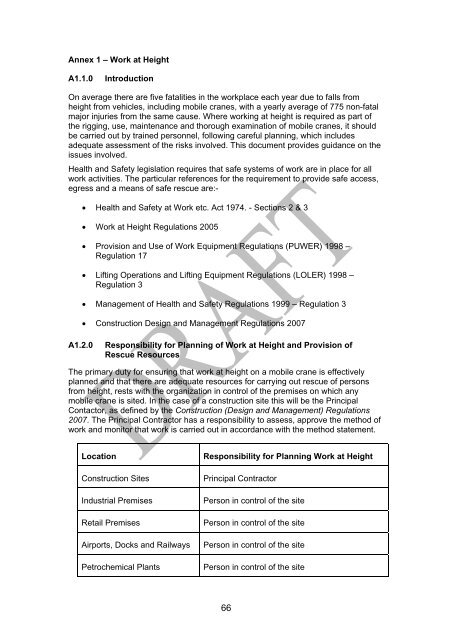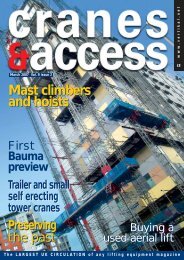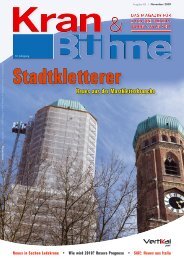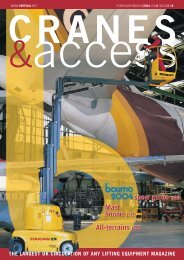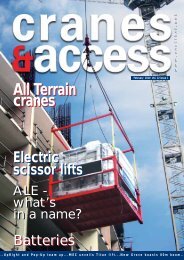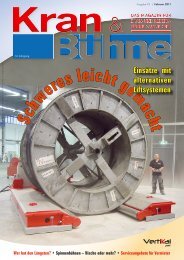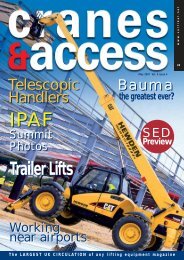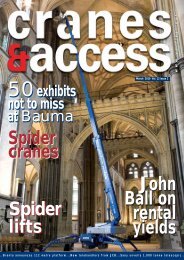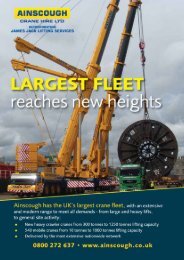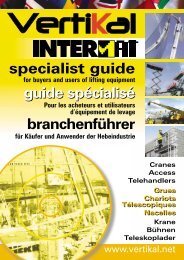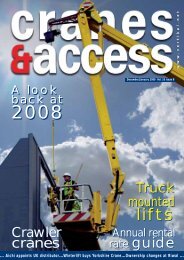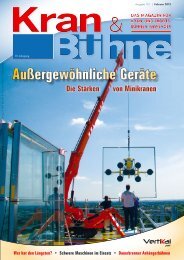Maintenance, Inspection and Thorough Examination of Mobile Cranes
Maintenance, Inspection and Thorough Examination of Mobile Cranes
Maintenance, Inspection and Thorough Examination of Mobile Cranes
You also want an ePaper? Increase the reach of your titles
YUMPU automatically turns print PDFs into web optimized ePapers that Google loves.
Annex 1 – Work at Height<br />
A1.1.0 Introduction<br />
On average there are five fatalities in the workplace each year due to falls from<br />
height from vehicles, including mobile cranes, with a yearly average <strong>of</strong> 775 non-fatal<br />
major injuries from the same cause. Where working at height is required as part <strong>of</strong><br />
the rigging, use, maintenance <strong>and</strong> thorough examination <strong>of</strong> mobile cranes, it should<br />
be carried out by trained personnel, following careful planning, which includes<br />
adequate assessment <strong>of</strong> the risks involved. This document provides guidance on the<br />
issues involved.<br />
Health <strong>and</strong> Safety legislation requires that safe systems <strong>of</strong> work are in place for all<br />
work activities. The particular references for the requirement to provide safe access,<br />
egress <strong>and</strong> a means <strong>of</strong> safe rescue are:-<br />
� Health <strong>and</strong> Safety at Work etc. Act 1974. - Sections 2 & 3<br />
� Work at Height Regulations 2005<br />
� Provision <strong>and</strong> Use <strong>of</strong> Work Equipment Regulations (PUWER) 1998 –<br />
Regulation 17<br />
� Lifting Operations <strong>and</strong> Lifting Equipment Regulations (LOLER) 1998 –<br />
Regulation 3<br />
� Management <strong>of</strong> Health <strong>and</strong> Safety Regulations 1999 – Regulation 3<br />
� Construction Design <strong>and</strong> Management Regulations 2007<br />
A1.2.0 Responsibility for Planning <strong>of</strong> Work at Height <strong>and</strong> Provision <strong>of</strong><br />
Rescue Resources<br />
The primary duty for ensuring that work at height on a mobile crane is effectively<br />
planned <strong>and</strong> that there are adequate resources for carrying out rescue <strong>of</strong> persons<br />
from height, rests with the organization in control <strong>of</strong> the premises on which any<br />
mobile crane is sited. In the case <strong>of</strong> a construction site this will be the Principal<br />
Contactor, as defined by the Construction (Design <strong>and</strong> Management) Regulations<br />
2007. The Principal Contractor has a responsibility to assess, approve the method <strong>of</strong><br />
work <strong>and</strong> monitor that work is carried out in accordance with the method statement.<br />
Location Responsibility for Planning Work at Height<br />
Construction Sites Principal Contractor<br />
Industrial Premises Person in control <strong>of</strong> the site<br />
Retail Premises Person in control <strong>of</strong> the site<br />
Airports, Docks <strong>and</strong> Railways Person in control <strong>of</strong> the site<br />
Petrochemical Plants Person in control <strong>of</strong> the site<br />
66


